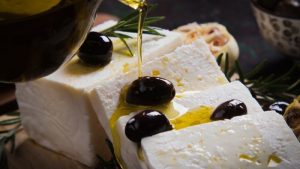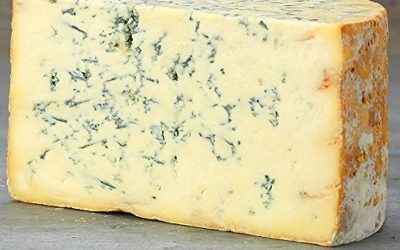Have you ever heard of Greek cheese? Feta is the most famous and popular cheese in Greece, being a cheese with a soft texture, white color and in brine. It is also a rich source of nutrients and an excellent source of calcium.
As a key ingredient in Mediterranean cuisine, Feta cheese is used in a wide variety of dishes, from appetizers to desserts.
Here you will find all the information you need about Feta cheese.
¿What is Feta Cheese?
Feta cheese originates from Greece and is the country’s most famous cheese. It is a soft, white-textured cheese in brine, which stands out for its high nutritional value and calcium content.
This cheese has a prominent presence in Mediterranean cuisine and is used in a wide variety of dishes, from appetizers and entrees to desserts.
Below, we provide you with all the necessary information about Feta cheese:
This product has a Protected Designation of Origin (PDO), which means that only cheeses made in certain regions of Greece can bear the name “feta”.
In these areas, Feta is produced from sheep’s and goat’s milk raised on local pastures. This particular environment is what gives the cheese its unique characteristics.
The flavor of Feta can be sharp when made from sheep’s milk, but milder when combined with goat’s milk.
Feta cheese is curdled in brine, which gives it a salty, tangy flavor. It is used in many dishes, such as salads, pizzas and pastas.
Feta comes in blocks and is firm to the touch. However, it can crumble when cut and has a creamy mouthfeel.

¿What are your substitutes?
If you are a person who does not enjoy the taste of Feta cheese, it could become a problem if you find yourself preparing a recipe that specifically calls for this ingredient. It is common for some people to not enjoy the strong flavor of Feta cheese, and look for suitable substitutes for it.
In this article, you will not only find a possible substitute for Feta cheese, but also alternative ingredients.

Halloumi
In case you don’t like the intense flavor of Feta cheese, Halloumi cheese could be an excellent choice for you, as it has a milder salty flavor. Like Feta, Halloumi is a Greek cheese, with a semi-hard and chewy texture. Even when cooked at high temperature, this cheese can maintain its firmness.
Halloumi cheese is an excellent alternative to Feta in Greek salads. If you want to add extra flavor, you can serve it with chopped mint or chili.
Fresh Cheese
If you are looking for a milder substitute for Feta, you may consider queso fresco, a type of cheese originating in Mexico that is commonly made from unpasteurized cow’s milk. The fresh, mild flavor of this cheese makes it ideal for egg dishes, salads and enchiladas.
Like other fresh cheeses, queso fresco has a lower fat and sodium content compared to Feta. Although it can be heated, it does not melt, but becomes creamy and soft. It has a sour and salty taste that can perfectly balance the spicy flavor of some dishes.
It is recommended to buy this cheese the same day it is going to be consumed, since its flavor is better when it is fresh. Although it can be stored in the refrigerator for several days, its texture and flavor may diminish with time.
Mozzarella Cheese
Mozzarella cheese can be found in curdled form and easily cut with a knife. In its traditional production, water buffalo milk is used, although in many countries such as Argentina, it is produced from cow’s milk. Fresh mozzarella has a mild, moist flavor, while low-moisture mozzarella is made from skim milk.
If you don’t like the crumbly consistency of feta cheese, you can try chunks of mozzarella in various recipes, such as salads, paella, seafood and meat dishes. Fresh mozzarella is one of those cheeses that you can make at home.
Ricotta Cheese
Ricotta or cottage cheese is an ally that you can get to replace feta, although its flavor is milder, its texture is similar and you could easily use it in the same meals and recipes.
¿How is Feta Cheese made?
Authentic Greek feta cheese is produced from sheep’s milk or a mixture of sheep’s and goat’s milk, in which goat’s milk cannot exceed 30%.
The milk can be pasteurized or raw. Lactic acid cultures are first added to separate the curds from the whey. Rennet is then added to solidify the casein protein. The curd is formed and placed in molds for one day.
Once the curd is firm, it is cut into cubes, salted and placed in barrels or metal containers for three days. The cheese is then immersed in a salty solution and refrigerated for two months before being packed in brine to maintain its freshness. This process is crucial to its distinctive flavor and texture.
¿How many calories does Feta have?
Feta cheese is a healthier choice than it seems. One serving (28 grams) provides
Calories: 74
Fat: 6 grams
Protein: 4 grams
Carbohydrates: 1.1 grams
Riboflavin: 14% of RDI
Calcium: 14% of the RDI
Sodium: 13% of the RDI
Phosphorus: 9% of the RDI
Vitamin B12: 8% of the RDI
Selenium: 6% of the RDI
Vitamin B6: 6% of the RDI
Zinc: 5% of the RDI
It also has decent amounts of vitamins A and K, folate, pantothenic acid, iron and magnesium.
In addition, feta has less fat and calories than aged cheeses such as cheddar or parmesan.
Compared to one ounce (28 grams) of cheddar or parmesan, which contain more than 110 calories and 7 grams of fat, one serving of feta has only 74 calories and 6 grams of fat.
Another advantage of consuming feta is that it is a richer source of calcium and B vitamins than other types of cheese, such as mozzarella, ricotta, cottage cheese or goat cheese.
Feta History
El queso feta es un queso blanco y salado que se ha producido en Grecia durante siglos y es uno de los quesos más populares en el país. Se cree que su origen se remonta al Imperio Bizantino y su nombre proviene de la palabra griega “feta”, que significa “rebanada”.
Tradicionalmente, el queso feta se ha elaborado con leche de oveja o con una mezcla de leche de oveja y cabra. Según la leyenda, los pastores y agricultores griegos almacenaban el queso en grandes bloques en salmuera para conservarlo durante los meses de invierno. Esta técnica de almacenamiento en salmuera ha ayudado a preservar el queso feta hasta la actualidad.
El queso feta es un ingrediente básico en la cocina griega, y se utiliza en muchas recetas, desde ensaladas hasta guisos y postres. En la década de 1960, la Unión Europea reconoció el queso feta como un producto con denominación de origen protegida (DOP), lo que significa que sólo se puede producir y vender con el nombre de “feta” si cumple con ciertos requisitos de calidad y se produce en Grecia.
Sin embargo, hay algunos países que producen un queso similar al feta y lo comercializan bajo ese nombre, lo que ha generado conflictos comerciales y legales en el pasado. A pesar de esto, el queso feta sigue siendo uno de los quesos más populares en todo el mundo, y se puede encontrar en muchos supermercados y tiendas especializadas de alimentos.
Frequently Asked Questions
What is so special about Feta
This cheese is recognized worldwide for its intense flavor and grainy texture. Besides, one of its main characteristics is that it does not use preservatives, so it could be said that it is a natural cheese.
This tasty dairy product is preserved in wooden and aluminum molds, and in this way you will see it in stores and cheese gondolas.
What is Feta cheese like in Argentina
This famous cheese of Greek origin is produced in Argentina with a semi-hard dough, with a brittle texture that melts in your hands. There are several factories that produce it in our country since it is recommended to be tasted in snacks and desserts of all kinds.
¿What kind of cheese is Feta?
As we have seen that this fresh cheese is generally made with sheep and/or goat milk and then left to rest in brine, it can be classified as a soft cheese. It is white in color and has no rind. It is also marketed in rectangular or wedge-shaped forms, which is why it is called Feta.
¿What is Feta like in the United States?
In the USA Feta is produced with cow’s milk, hence its milder flavor. It is widely used in salads and is often combined with fruits.
¿How long does it last and how can it be preserved?
This Greek cheese is characterized by a shelf life of 2 weeks while retaining its fresh and healthy texture. If it is not properly refrigerated and preserved, its flavor may become bitter and the edges may dry out, losing its original color and becoming somewhat yellow.
The ideal way to preserve it is to make a homemade brine: 1 tablespoon of salt in 250 ml of water in a tupper or container, and place the cheese inside and then cover it.
It is advisable to change the water weekly to preserve the characteristics and flavor of the cheese.
¿Is it healthy?
According to research from the University of Life Sciences, the consumption of fresh cheeses such as Feta is not associated with weight gain, on the contrary, it could contribute to your body balance. However, not all people benefit in the same way and there are even those who are intolerant to this product. Besides, since this cheese does not contain preservatives, it can be said that it is healthier than others with higher fat content.
¿How to know if Feta is in bad condition?
To know if Feta is bad or in bad condition, you should observe changes in its color, the presence of mold, differences in the smell or taste of the product. In this case the recommendation is not to consume it and to discard it immediately.






0 Comments